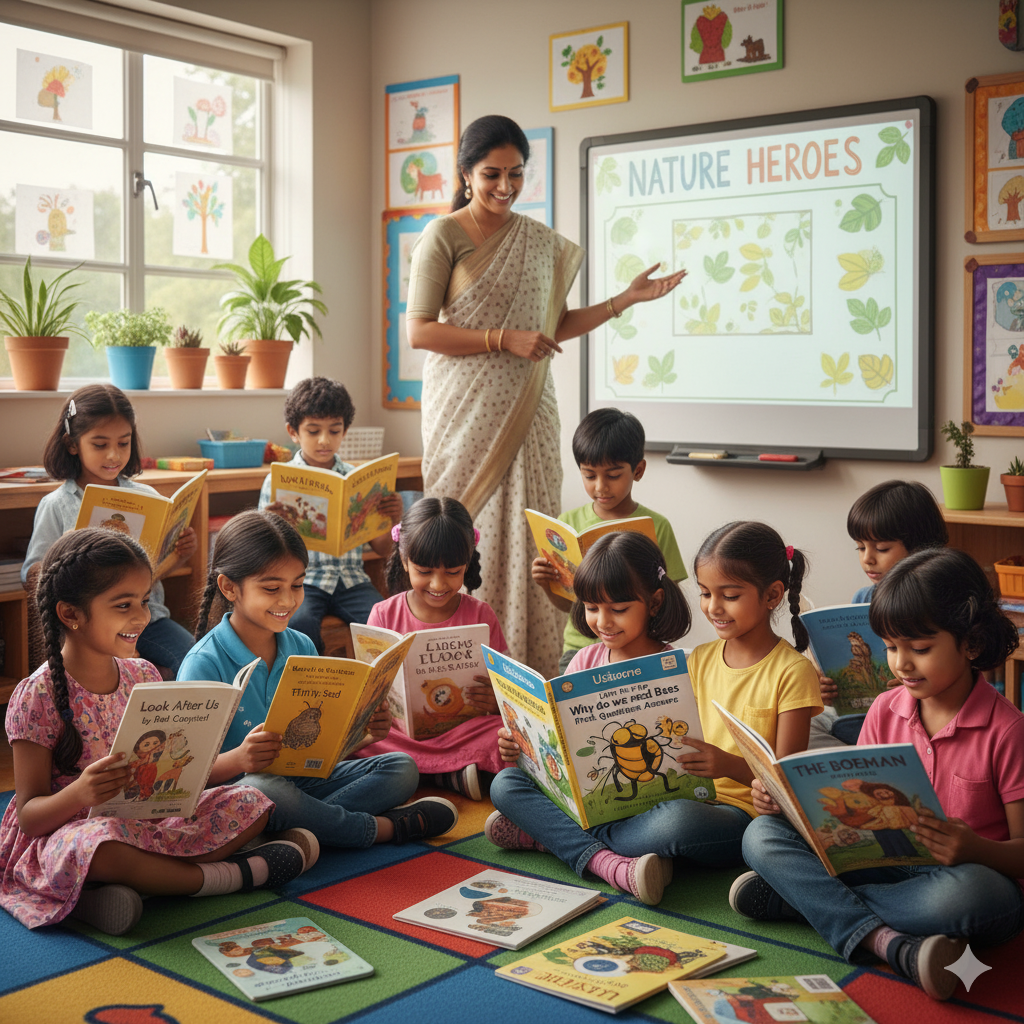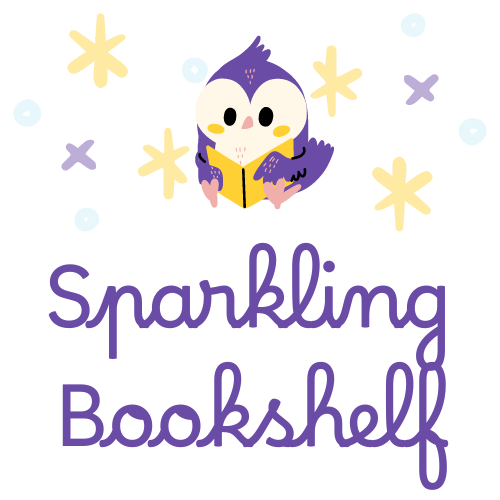
10 Must-Have Books on the Environment for Kids
Remember that moment when your child first pointed to a flower, or asked you what bees do or where does dustbin waste goes? These questions show that your child has curiosity to know about their surroundings. Their environmental consciousness can be satisfied through books, books that teach them about nature and its issues.
In today’s time it is important for kids to have early knowledge about issues like pollution, deforestation, water shortage etc. So that they can think and act on the solutions to save the environment. And in this, the environmental books for kids become a great source of inspiration to guide them towards saving nature.
How Books Teach Kids About the Environment?
Pollution, deforestation, and climate change may feel too big for children to grasp, but books make these issues relatable. Through simple stories and characters, kids see how plastic harms oceans, how cutting trees affects animals, or how wasting water impacts daily life. The solution lies in showing small, doable actions, like planting trees, saving energy, or reusing items, that empower them instead of overwhelming them. Books bridge the gap between problem and solution, teaching kids that even small choices matter. When children see heroes caring for the planet, they believe they can too.
Green Reads: Best Children’s Books on Nature and Sustainability
Here are the best environmental books we recommend for inspiring your child to love and protect the world. These environment books for kids are foundational reads for any green bookshelf!
1. Look After Us by Rod Campbell (Age: 1 to 3 years)

"Look After Us" by Rod Campbell is a lift-the-flap board book for toddlers that introduces five endangered animals—like tigers, elephants, and orangutans—in their natural habitats. Using simple language and colorful art, it gently encourages children to care for wildlife and shows how caring actions can help protect animals. The book teaches little ones that looking after animals means looking after the world we all share.
2. The Lorax by Dr. Seuss (Age: 4 to 8 years)
This story is about a beautiful forest full of Truffula trees that gets destroyed because someone keeps cutting them down to make products. The Lorax, a small creature, speaks for the trees and warns against harming nature. It teaches kids that if we use too much of the earth’s resources without caring, animals lose their homes and the environment suffers. The big lesson is that everyone—even children—can make choices to protect nature, like planting trees, saving resources, and respecting the planet.
3. Michael Recycle by Ellie Bethel (Age: 3 to 6 years)
This fun, superhero-style story introduces kids to recycling in a playful way. Michael Recycle swoops into town to show people how their messy habits hurt the environment—and how cleaning up, reusing, and recycling can make a big difference. For young children, it’s an exciting first lesson that taking care of the planet doesn’t have to be boring or difficult. The book teaches that even small actions, like sorting waste or reusing items, help keep our world clean.
4. Usborne Lift the Flap Why do we need Bees First Questions Answers (Age: 4 to 7 years)

Usborne Lift the Flap: Why Do We Need Bees? introduces children to the vital role bees play in nature. With fun flaps and easy questions, it explains how bees pollinate flowers, help plants grow, and even support the food we eat. Kids learn that protecting bees means protecting our environment. It gently shows why small creatures matter and how caring for them keeps the planet healthy.
5. The Tiny Seed by Eric Carle (Age: 2 to 5 years)
This beautifully illustrated story follows a tiny seed’s journey through the seasons—facing wind, sun, and snow—until it finally grows into a towering flower. In simple, gentle words, it teaches kids about the life cycle of plants, patience, and resilience. Children learn how nature works step by step and why every little seed matters, sparking curiosity and care for the environment.
6. Last Tree in the City (Age: 4 to 8 years)

Last Tree in the City tells the story of a young boy who discovers the last tree in a grey, concrete city. When it’s cut down, he feels the loss deeply but finds hope by planting new seeds. The book introduces kids to deforestation in a simple way, showing how trees bring life, beauty, and balance, and how even one small act can help nature grow again.
7. The Beeman by Laurie Krebs and Valeria Cis (Age: 3 to 7 years)
"The Beeman" follows a young child learning about beekeeping from their grandfather. Through gentle rhymes and colorful illustrations, kids discover how bees make honey, the different roles inside a hive, and the basics of beekeeping. The book teaches children that bees are important for making honey and pollinating flowers, helping them understand how bees support nature and why it's important to protect them.
8. The Life of a Little Cardboard Box (Book on reusing & recycling) (Age: 3 to 6 years)
This is a fun, imaginative story that follows a simple cardboard box as it gets transformed again and again. It starts as a container, then becomes a race car, a house, and other fun creations before finally becoming a new box.The book teaches a crucial lesson about reusing and recycling through play. It encourages kids to look at waste as a resource, showing them that materials like cardboard can have many exciting lives before they ever need to be thrown away.
9. The Life of a Little Plastic Bottle (Story about reusing and recycling) (Age: 3 to 6 years)

The Life of a Little Plastic Bottle follows a plastic bottle from the factory to its eventual journey into the ocean or landfill, highlighting the problem of waste. This book gently teaches reusing, reducing, and recycling—three vital actions. It shows kids that plastic doesn't disappear and encourages them to be responsible by ensuring their trash doesn't harm the earth or its creatures.
10. Usborne Lift-the-flap Look Inside What We Throw Away (Age:5 to 8 years)
Usborne Lift-the-flap Look Inside What We Throw Away uses interactive flaps to take kids on a fascinating journey, revealing what happens to trash after it leaves the bin. It shows how recycling centers, compost heaps, and landfills work. This book teaches waste management and sustainability. It shows kids the real-world impact of their trash, motivating them to reduce, reuse, and recycle by making the often-hidden process clear and engaging.
Conclusion
Reading these foundational environmental books for kids is the most wonderful first step in raising a kind, conscious, and planet-loving child. They empower your little one with crucial knowledge, from the importance of planting more trees to the basics of effective waste management. The most actionable lesson they learn is the power of the 3R’s: recycle, reduce, reuse.
Don't wait to start this important conversation. Shop our wide collection of kids nature books and other environment books for kids today at Sparkling Bookshelf, and help your little one grow into a green hero!
Frequently Asked Questions (FAQs)
1. What is the best age to introduce environmental books to my child?
The best time to start is around age two or three (toddler stage), using simple, engaging environment books for toddlers with bright illustrations.
2. Should I focus on fiction or non-fiction environmental books?
Use fiction (like The Lorax) to build empathy and non-fiction (like Usborne's Lift-the-Flap books) to teach concrete facts and answer "how" and "why."
3. How can I reinforce the lessons from these kids' environmental books at home?
The best way is through action! Connect the stories to real life by involving your child in the 3R’s (recycle, reuse, reduce), saving water, and planting seeds, making them little environmental heroes.
